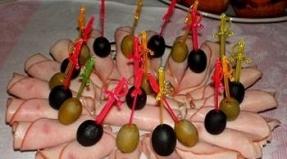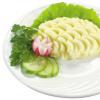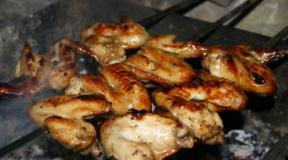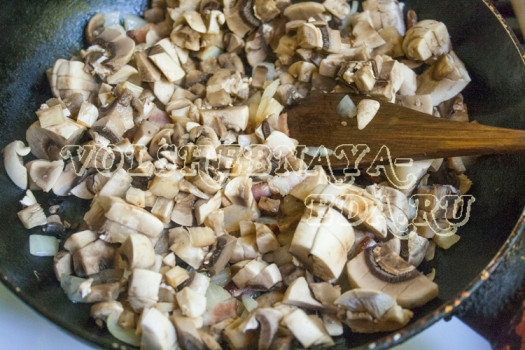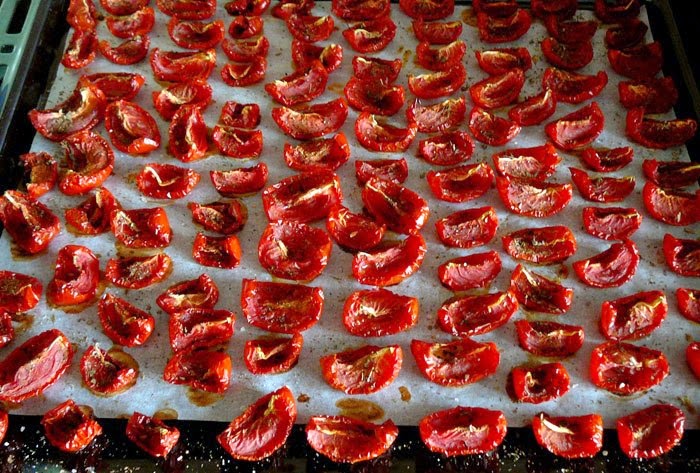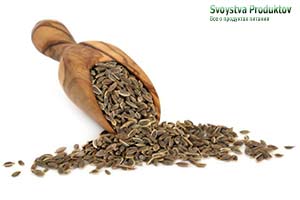Pickles for the winter. Salting vegetables for the winter
The festive table is traditionally decorated with pickles: cucumbers, tomatoes, eggplants, mushrooms, even apples (they are often called soaked, but the cooking technology is salting). Appropriate pickles, while respecting the rate of consumption, to enrich the everyday menu.
Benefits of pickles:
Proper preparation for the winter by salting directly contains the product, salt, vegetable spices (garlic, pepper, horseradish, aromatic greens), and water.
Pickles are low in calories, but whets the appetite. They supply the body with fiber, necessary for the normalization of digestion and having, according to research by scientists, the ability to reduce the risk of cancer.
Pickles contain beneficial trace elements (iodine, magnesium, potassium, iron), vitamins. In the process of natural fermentation during salting, lactic acid is formed, normalizing digestive functions.
Of course, pickles can be bought. But it is expensive and does not always meet the expectations. After all, to simplify the process and extend shelf life, some manufacturers use acids (acetic, citric and others) that are not suitable for every health condition.
What do you get in the rubric?
We picked up proven recipes, from which you will become aware of the secrets of cooking technology and the proportions of ingredients. Following the step-by-step instructions, you will prepare for the winter and fill the bins with tasty and healthy pieces.
Salting labor can bring joy!
To do this, do not forget about the family and do not turn home cooking into a cannery. It is better to share the duties and ask loved ones to help. Behind sincere conversations and the cooking process will pass quickly, and the family will receive additional communication time. Then in the winter, setting the table, you will remember pleasant moments of joint culinary creativity, and not heavy penal servitude.
Pickling homemade various vegetables for the winter is a small but very responsible duty of every hostess. After all, in any family in the winter, when there are not enough fresh vegetables, they love to eat tomatoes and cucumbers. And this is possible only under one condition: that in the pantry or in the cellar there are jars of canned vegetables. That is why in the autumn in the kitchens the work on the harvesting of vegetables is in full swing, the most interesting and tasty recipes for the individual look are found and selected. But why shovel the mountains of literature in search of the right recipe, when all the most popular of them are collected on our website site in the section "Salting".
Salting is one of the means of preserving and preserving vegetables using ordinary table salt. Thanks to it, harmful bacteria are destroyed, causing the appearance of mold, due to which homemade pickles deteriorate. In addition to this important factor, salt has a positive effect on the taste of vegetables; with her pickling at home gets a pleasant, peculiar taste.
Pickling cucumbers, tomatoes and other vegetables is considered the most simple and reliable way to store them for a long time. Preservative substances are salt and lactic acid, preventing vegetables from spoiling.
With us you have a wide assortment of salted tomato: hot and cold salting, salting green tomatoes, assorted salting with cucumbers, salting stuffed tomatoes, cooking lightly salted tomatoes and salting tomatoes with apples. The site presents the methods of “How the salting of mushrooms is done correctly” - black salmon, chernushki, red mushrooms, honey agaric and, of course, salting of the waves. After all, without jars in which the pickling of mushrooms is closed for the winter, your pantry with winter reserves will be incomplete.
Recipes for pickled cucumbers represent the largest range in the pickling section. And for good reason! After all, pickling cucumbers most popular and in demand. Only salting of tomatoes for the winter can compete with it. Among the diverse recipes for harvesting cucumbers, you can find both traditional ways of cooking them (cold salting or hot salting, harvesting according to village recipes, harvesting lightly salted cucumbers, salting in mustard, etc.), and quite unusual ones (for example, salting in a package).
In addition, we will tell you how to pickle dill for the winter and how to ferment cabbage and watermelon. Using our recipes, you are unlikely to make mistakes when salting or fail. This can occur only if they are stored improperly (the optimal storage temperature for pickles is slightly above 0 ° C) or due to fermentation.
Salting vegetables for the winter is a whole art combining vegetables, spices, seasonings and spices. We note that the "command" salted vegetables, especially according to our recipes, everyone can, regardless of age or gender. After all, there are materials for salting in any kitchen. Well, patience and desire will arise by itself, as soon as you remember how pleasant it is in winter to open a jar of pickles and put it on the table with pride.
Salting products - one of the ways to save them for the winter and home canning. Salted vegetables in brine, the recipes of which can be different, as well as in a dry way with various spices. Here are some examples of pickled cucumbers and splendid sauerkraut at home.
Salting at home
Cucumbers are laid out on the banks (you can put horseradish leaves, dill, currant leaves, washed with running water between them). A cold pickle is poured on top of the cucumbers. It needs to be prepared from 60 grams of salt per liter of water. Boil and cool. Banks are closed with a cloth or gauze and left to wander on the table in the kitchen, in a warm place, for two days. After this, the brine fermentation process can be completed.
Move the jars under gauze to cool in the cellar or in the refrigerator. When keeping cucumbers in a warm room for a long time, voids will form inside them when pickling, as excessively rushing gases in them will tear cucumbers from the inside. After 10-12 days, cork the banks without sterilization and store cucumbers at a temperature not higher than 3-4 degrees.
Winter salting recipes
But the recipe is excellent salty cabbage in brine. Cabbage is obtained after such salting (pickling) crispy, juicy, spicy. Prepare a pickle for it at the rate of two tablespoons of non-iodized salt, one tablespoon of sugar per liter of water. Water with spices boil? Turn off, let cool completely.
Next, do shredding cabbage. Chop it at will, either with a thin straw or small cubes, for a change, if you pickle a lot of cabbage, chop one head into slices and chop the rest of the cabbage finely. Subsequently, the cabbage pieces should simply be put in the middle of the pelvis between the chopped cabbage or on the bottom of the dish, in which you will pickle the cabbage.
Also shred carrots on a coarse grater or straws. Per pound of cabbage will need approximately one average carrot. We also peel the garlic, cut it into slices in an arbitrary quantity.
We shift the cabbage with layers of carrots, add garlic, a couple of bay leaves to each layer of cabbage. Pour the brine on top so that it covers the cabbage completely. Cover with a plate on top, rearrange wander to a warm place. Touching the cabbage is not even necessary in the process of fermentation. After about 3 days, it should be put in clean jars, put the brine on top and put under plastic covers in the refrigerator or cellar.
Homemade, cooked according to original recipes, is quite capable of diversifying the menu of your family as well as purchased delicacies.
A weighty plus is in favor of pickles - they are very easy to prepare: it is not at all necessary to be a cooking guru to indulge your family with crispy cabbage or aromatic pickles of your own cooking. It would be a desire, and the original recipes are already waiting for your attention! See, read, choose to your taste!
- Tomatoes - 2 kg.
- Water - 2 liters.
- Cherry leaves - 5 pcs.
- Raspberry leaves - 5 pcs.
- Black currant leaves - 5 pcs.
- Celery - 8-10 branches.
- Horseradish (leaves) - 2 pcs.
- Allspice - 5 pcs.
- Garlic - 5 zubkov.
- Coarse salt - 4 tbsp. spoons (no slides).
Recipe:
- Tomatoes are washed.
- Containers for pickling are also thoroughly washed (it is not necessary to sterilize).
- Cherry leaves, currants, raspberries, horseradish and celery are washed.
- Garlic cloves are peeled from the husk.
- They put in a container: first washed leaves, allspice and peeled garlic, then tomatoes.
- From the cold (ideally - well) water and salt make saline.
- Top down poured them tomatoes.
- The container is closed with a lid and cleaned in a cold place (cellar or basement) for further storage.
- Lemons - 500 gr.
- Hot peppers - 2 pcs.
- Lemon juice - 150 ml.
- Rosemary (twigs) - 2 pcs.
- Coarse salt - 100 gr.

Recipe:
- Wash thoroughly and blanch in boiling water (approximately 5 minutes).
- After removing it from the boiling water, it is immediately cooled for several minutes under running cold water, after which it is wiped dry.
- Each fruit is cut into 8 pieces. They do it this way: first, the lemon is cut into 4 pieces lengthwise, then each of the parts is divided in half (across).
- Prepare a pickle, which is mixed with lemon juice and salt.
- Tare for pickling thoroughly washed, dried.
- At the bottom are placed twigs.
- Lemon slices are placed on top of the rosemary.
- Hot pepper is washed, cleaned from the stem and seeds and spread on the lemons.
- Into the container filled to the top, the brine prepared from the juice of lemon and salt is poured.
For cooking you will need:
- Watermelon - 2 kg.
- Dill - 1 bunch.
- Celery (leaf) - 5 branches.
- Hot peppers - 1 pc.
- Horseradish (root) - 1 pc.
- Garlic - 3 cloves.
- Coarse salt (per 1 liter of water) - 3 tbsp. spoons (no slides).
- Sugar (per 1 liter of water) - 3 tbsp. spoons (no slides).

Recipe:
- Washed cut into pieces (together with the skin), the size of which depends on the selected container.
- Carefully wash the horseradish root and hot peppers, and celery.
- Garlic is peeled.
- Greens, horseradish, hot pepper and garlic are placed in a container (it is enough to wash it thoroughly, it is not necessary to sterilize it).
- On top of a layer of green watermelons are laid.
- Brine is prepared from water, salt and sugar: for every liter of water, 3 tbsp. spoons of salt and 3 tbsp. spoons of sugar.
- Cooked brine pour watermelon in such a way that the liquid covered the pieces completely.
- From above set the oppression and leave it for 2 days (for fermentation).
- Then the oppression is removed, the container with watermelon is closed with a lid and removed for storage (in a refrigerator or a cool room).
- Tomatoes - 4 kg.
- White cabbage - 1.2 kg.
- Bulgarian pepper - 1.2 kg.
- Carrots - 150 gr.
- Onion - 100 gr.
- Horseradish (leaves) - 20 pcs.
- Horseradish (root) - 6 pcs.
- Celery (petiolate) - 1 bunch.
- Dill (greens) - 1 bunch.
- Parsley - 1 bunch.
- Black pepper (peas) - 100 gr.
- Garlic - 1 head
- Coarse salt - 150 gr.
- Sugar - 1 tbsp. spoon.
- Water - 5 liters.

Recipe:
- Tomatoes, horseradish and all greens are carefully washed.
- and horseradish root washed and cleaned.
- and garlic peeled.
- The peppers and seeds are removed from the pepper.
- Make a brine: in water dissolve salt, sugar, add black pepper, dill, parsley and celery. Put on a small fire, bring to a boil, turn off and allow brine to cool.
- Prepare cabbage stuffing: carrot rubbed on the largest grater, onions cut into small cubes, finely chop the cabbage. Mix it all together, add a little salt and knead with hands until juice appears.
- Pepper stuffed, slightly sealing the filling with your fingers or a spoon.
- Horseradish and garlic cut into small pieces.
- The tank for tursh is thoroughly washed, placed into it: first - half of the greens from the brine, on top - stuffed peppers, tomatoes, pieces of horseradish and garlic.
- A container filled with vegetables is poured with a cooled brine, a pressure is set on top and, covered with gauze, is left for 4-5 days at room temperature.
- As soon as fermentation begins and the brine becomes cloudy, a container of vegetables is transferred to a cold room for further storage.
- It will be possible to serve the table in Gagauz in about a month.
- Tomatoes - 2 kg.
- Cherry leaves - 3 pcs.
- Black currant leaves - 3 pcs.
- Dill (umbrellas) - 2 pcs.
- Basil (twigs) - 5-8 pcs.
- Horseradish (leaves) - 2 pcs.
- Coarse salt - 1.5 Art. spoons (no slides).
- Garlic - 3 cloves.
- Water - 1 l.

Recipe:
- Tomatoes, leaves of cherry and black currant, as well as umbrellas of dill, horseradish and carefully washed.
- Tomatoes are pierced (with a fork or toothpick) in the area of attachment of the stem.
- Garlic peeled.
- Tare for salting thoroughly washed.
- Greens and garlic chopped.
- First, put greens and garlic in a container, then fill them to the top with tomatoes.
- Prepare a brine: in 1 liter of water dissolve 1.5 tbsp. spoons of salt.
- Tomatoes are poured with brine and taken out in a cool room (ideally, a cellar or basement).
- They will be ready in about a month.
For cooking you will need:
- Tomatoes - 2 kg.
- Dill (umbrellas) - 3 pcs.
- Horseradish (leaves) - 3 pcs.
- Bay leaves - 5 pcs.
- Black pepper peas - 5 pcs.
- Allspice - 5 pcs.
- Garlic - 1 head.
- Mustard powder - 20 gr.

Recipe:
- Tare for salting can not be sterilized, wash it thoroughly enough.
- Tomatoes are washed and prick each at the base (with a fork, skewer or toothpick).
- Sheet horseradish and dill are washed and spread on the bottom of the pickling vessel.
- clean, wash, each tooth is cut in half and spread over a layer of greenery.
- Then fill the container to the top with tomatoes.
- Prepare a pickle: put salt in the water, add bay leaf, black and allspice; give boil, and immediately removed from the fire.
- In the cooled brine add mustard powder, mix well and pour the tomatoes.
- The container is left for 3-5 days at room temperature, after which it is placed in a cool room where tomatoes can be stored for a long period of time.
- It will be possible to remove the sample from the workpiece in about a month.
- Eggplant - 5 kg.
- Basil - 20 branches.
- Parsley - 1 bunch.
- Garlic - 2 heads.
- Bay leaf - 3 pcs.
- Coarse salt (for garlic) - 25 gr.
- Large crystal salt for brine (per 1 liter of water) - 75 gr.

Recipe:
- Eggplants are washed, cut the stalk and cut along.
- They are blanched in salted (per 1 liter of water 20 g. Of salt) boiling water for 10 minutes.
- Then they are placed in a colander and left there for some time to drain the excess liquid.
- After that, they are laid under the oppression: removed from the colander, squeeze out water and put on the kitchen board (under the board you need to put something in order to form a slope). On top of the eggplant put another board, which set the load. Under the yoke, eggplants should stand for at least three hours (during this time, all the excess liquid will drain out of them).
- Garlic is peeled, minced with a garlic crush, and mixed with salt.
- Garlic-salt mixture rub the pulp through the incisions.
- and basil wash, drain.
- A container for pickling vegetables is washed and eggplants are laid into it, interbedded with parsley, basil, and bay leaves.
- Brine is prepared from water and salt, allowed to boil, cooled. Pour eggplants, put oppression. About a week incubated at room temperature.
- After 7 days, the pressure is removed, the container is closed with a lid and transferred to a cold room for subsequent storage.
- After about 3 weeks, the eggplants with basil are ready for serving.
- Eggplant - 2.5 kg.
- Celery leaf - 10 branches.
- Carrots - 0.5 kg.
- Onion - 0.3 kg.
- Garlic - 2 heads.
- Vegetable oil - about 50 ml.
- Coarse salt (based on 1 liter of water) - 80 gr.

Recipe:
- Eggplants are washed, the stalks are cut, and each is incised in the middle along.
- Dip in boiling salted water (20 grams of salt per 1 liter of water) and boil over low heat for about 15 minutes.
- After a quarter of an hour, eggplants are placed in a colander, allowed to drain off excess water and placed under a press for 3 hours.
- washed and finely chopped.
- Onions are peeled and cut into small cubes.
- Carrots are washed, cleaned and rubbed on a coarse grater.
- Chopped celery combine with carrots and onions.
- Garlic is cleaned, crushed with a garlic press, combined with vegetable oil.
- Eggplant pulp is rubbed with this mixture (through cuts).
- Each eggplant is filled with a mixture of carrots, onions and celery so that it peeks slightly from the cut.
- Stuffed eggplant folded in a prepared container.
- Brine is prepared from water and salt, brought to a boil, allowed to cool. Eggplants are poured over them and set the oppression.
- For further storage, the workpiece is cleaned in a cool room.
- Ready eggplant in about a month.
- Squashes - 3 kg.
- Horseradish (root) - 100 gr.
- Horseradish (leaves) - 10 pcs.
- Basil - 15 branches.
- Coarse salt - 2 tbsp. spoons (1 l cold water).

Recipe:
- Squashes (preferably young thin-skinned fruits) are carefully washed and cut into circles about 2 centimeters thick.
- Basil branches, leaves and root thoroughly washed.
- Carefully wash the pickling tank.
- Then put into it chopped zucchini, alternating them with sprigs of basil, leaves and horseradish root.
- From cold (ideally - well) water and salt, brine is prepared, which is filled with zucchini poured to the top (so that the brine covers them completely).
- Capacity for several days left at room temperature.
- As soon as active fermentation is completed, it is covered with a lid and removed for further storage in a cool room.
- Green tomatoes - 3 kg.
- Bulgarian pepper - 1 kg.
- Cherry leaves - 10 pcs.
- Black currant leaves - 10 pcs.
- Horseradish (leaves) - 5 pcs.
- Garlic (teeth) - 5 pcs.
- Coarse salt (based on 1 liter of water) - 2 tbsp. spoons (with a small slide).

Recipe:
- Green tomatoes are washed and gently removed the stem.
- Garlic is cleaned, washed, cut each tooth in half.
- Bulgarian pepper washed, remove the stem and seeds.
- In a pre-prepared (washed) container spread, alternating layers: leaves, and horseradish, chopped garlic, Bulgarian pepper and tomatoes.
- From cold water and salt is prepared brine, which is poured tomatoes.
- The container is closed with a lid and cleaned in a cool room for further storage.
- Tomatoes made according to this recipe are ready to eat after 25-30 days.
- Squash - 2 kg.
- Apples - 0.5 kg.
- Currant leaves - 25 pcs.
- Coarse salt (based on 1 liter of water) - 2 tbsp. spoons (no slides).
- Mustard powder - 2 tbsp. spoons.

Recipe:
- wash, remove the stem, the fruits are cut into slices 2 centimeters thick.
- washed, cleaned from the core and cut into large slices.
- Tare for salting wash.
- Then it alternately placed: currant leaves, slices of squash and apples.
- Prepare the brine: put salt, sugar and mustard into the water, mix everything well.
- The scallops fill the container with a lid and store it in a cold room for storage.
- In 25-30 days the squash is ready for serving.
For cooking you will need:
- White cabbage - about 2 kg.
- Cumin (or dill seeds) - 1 tbsp. spoon (no slides).
- Carrots - 2 pcs.
- Coarse salt (per 1 liter of water) - 1 tbsp. spoon (with a small slide).
- Honey (1 liter of water) - 1 tbsp. spoon.

Recipe:
- washed and cut into large pieces.
- Carrots are cleaned, washed and cut into slices with a thickness of 0.3-0.5 cm.
- Capacity for making pickles washed.
- Then they put cabbage and carrots into it, sprinkled with (dill).
- Put honey and salt in water, stir until complete dissolution.
- Cooked brine poured cabbage.
- After 2-3 days, cabbage can already be eaten.
- White cabbage - 2.5 kg.
- Beets - 0.5 kg.
- Carnation - 2 pcs.
- Bay leaf - 2 pcs.
- Black pepper (peas) - 10 pcs.
- Coarse salt (based on 1 liter of water) - 2 tbsp. spoons (without top).
- Sugar (per 1 liter of water) - 1 tbsp. spoon.

Recipe:
- Cabbage (small heads) are cut into 4 pieces.
- wash, clean and cut into circles or straws.
- The tank for pickling is thoroughly washed, after which the cabbage and beets are shifted into it, alternating between them.
- Bring the water to a boil, put in it sugar, salt, bay leaf, cloves, black pepper and remove the brine from the fire.
- Pour the cabbage to the top with the cooled brine.
- Leave it at room temperature for 2 days.
- After 2 days, the cabbage in several places pierced with a fork, if necessary, add brine.
- For further storage clean in a cool room.
Salt is completely dissolved in cold water.
Pickled cucumbers "like a barrel"
For cooking you will need:- Cucumbers - 5 kg.
- Dill - 4 bunches.
- Cherry leaves - 30 pcs.
- Horseradish (leaves) - 15 pcs.
- Oak leaves - 20 pcs.
- Pepper (chilli) - 1 pc.
- Allspice - 10 pcs.
- Garlic - 3 heads.
- Bay leaves - 5 pcs.
- Coarse salt (per 1 liter of water) - 2 tbsp. spoons (with a small slide).

Recipe:
- Cucumbers are thoroughly washed and soaked in cold water for several hours.
- Capacity for pickling cucumbers carefully washed.
- Garlic is peeled and cut in half each tooth.
- Thoroughly wash the dill, hot peppers, horseradish leaves, oak and cherry.
- Garlic, half of dill, half of leaves of oak and cherry, bay leaf, as well as chopped garlic, allspice and chilli peppers are placed on the bottom of the container for pickling.
- Then cucumbers are placed tightly, filling the container almost to the top. If the fruits are not the same size, then first (at the bottom) lay the largest, then medium, in the upper layers - the smallest.
- Spread the remaining dill, cherry, and oak leaves on top of the cucumbers and cover them with horseradish leaves.
- Put salt in cold water (2 tablespoons with a small slide of 1 l), stir until completely dissolved.
- Pour green stuff so that the brine covered them completely.
- A yoke is placed on top (a jar of water, for example, placed on a plate) and cucumbers are left at room temperature for 7-10 days.
- When foam will form on the surface, it must be removed every day, and the plate on which the oppression stands must be washed.
- As soon as the cucumbers acquire olive color, the oppression is removed. The top layer of greens gently pull out, carefully washed and put back.
- The container is closed with a lid and stored for storage in a cool room.
- In about a month, fragrant cucumbers are fully ready for use.
The article is placed in sections:
- This is the most reliable, simple and popular way to preserve the crop. Salt and lactic acid are preservative substances at salting. They protect vegetables from spoilage and delay the development of harmful microorganisms. In addition, it is lactic acid that gives vegetables a specific flavor. So, we harvest vegetables for the winter using the salting method!
Salting vegetables for the winter. Recipe with photos for tomatoes
Tomatoes are those vegetables that are the most popular in winter harvesting. Only cucumbers can compete with them. Tomatoes are salted with different methods. But consider the cold salting method. For harvesting selected tomatoes of any shape, of any variety and of different degrees of ripeness. True red tomatoes become too soft when pickled; therefore, saline them better in three-liter glass jars. Brown and green tomatoes can be salted in the sides, in buckets, etc.Brine for salting red and pink tomatoes is prepared in the calculation of 1 kg of salt per 10 liters of water, and for green and brown tomatoes - 0.7 kg of salt per 10 liters of water. When salted, greens, dill umbrellas, black currant leaves, horseradish leaves and roots are laid in the container for tomatoes. Tomatoes in cans are poured with cold pickle and left for fermentation uncorked in a cool place for 10 days. Having checked salted tomatoes in jars for readiness, they should be hermetically sealed with metal lids. Store salted tomatoes in a cool place.
In addition to cold pickles, also applies to tomatoes. But this method is more laborious, as it requires repeated, short-time infusion of tomatoes poured with hot pickle, followed by draining and reheating.

Salting cucumbers
“Cucumbers. Salting vegetables for the winter "recipes not inferior in demand for tomatoes. For salting, per 10 kg of cucumber, 0.3 kg of dill greens, 50 g of horseradish roots, 50 g of garlic, 10 g of hot peppers are taken. To your own taste, you can additionally pick up the roots and greens. Greens, it is desirable to use fresh, washing it before laying under cold water. The total weight of spices and greens should not exceed 6% by weight of cucumbers.Washed and drained cucumbers are packed tightly in cans (preferably vertically). Rows of cucumbers need to shift the spices and pour boiled brine, prepared from 10 liters of water and 0.6-0.7 kg of salt. Before pouring the brine be sure to strain. Greens - put on the bottom of the cans, and on top - cucumbers. After the can, it should stand for 3-4 days at home and, when the cucumbers are salted, transfer the container to a cooler place, covering the cans with nylon caps.
Salting cucumbers must be kept in the cold; even a little frost will not hurt them. In the heat, they quickly turn sour and deteriorate.

Salting vegetables for the winter recipe for squash and squash
For salting zucchini and squash should be moderately mature, with dense flesh and delicate skin. But by no means overripe! Before salting, the vegetables are washed out in cold water, the tops are cut off from them, and after the vegetables they are picked up with a wooden skewer in several places. Then the zucchini are stacked tightly to each other in rows, and between them is laid greens: celery, dill, cherry leaves and black currants, tarragon, parsley. Spicy spices when salting zucchini and squash can be 1.5-2 times more than the vegetables themselves. Next, pour the brine, prepared in the calculation: 1 liter of water - 60-80 g of salt. Squashes are covered and left to ferment and mollify for 5-7 days. After they need to be moved to a cold place for long-term storage.

Salting watermelons
Of course, watermelon (as many know) is not a vegetable, but a berry. But since it is harvested in the winter by salting, then it can be safely categorized as salting vegetables. Only fine-grained, mature watermelons of small size (up to 2 kg) are suitable for salting. The best period for salting watermelons is September-October, since they must be stored at low temperatures, otherwise they will ferment quickly.
Salt watermelons can be as follows. Watermelons are sorted, washed and punctured in several places (to accelerate fermentation). Then the watermelons fit tightly into a suitable container (for example, in a barrel) and are poured with brine (60-80 g of salt is taken for 1 l of water), then they are covered with a lid and kept for 2-3 days at a temperature of about 20 C. in a room with a lower temperature, topping up the brine if necessary and covering it tightly with a lid. The favorable temperature for storing salty watermelons is +1 ... -10 C. On average, the fermentation process lasts 15-20 days, and these can be tried.

Salting vegetables for the winter. Step by step recipe onions
In onions, you can pickle feathers and turnips. In the first case, green onions are removed, removing the affected, flaccid and dried feathers. After fresh greens, they are washed and cut into pieces 2-3 cm long. Cut onion feathers are put in jars as tightly as possible, and bay leaf, allspice are added to them, salt is poured (about 5-7% of the total onion mass). Banks are covered not too tightly with nylon covers, left in a cool place to “ripen” and in 2-3 weeks you can try the blank.For pickling onion turnips, it is better to select small, immature bulbs. They should be cleaned, washed in cold water and, like the greens, put in jars with spices (but without salt). After the brine is poured into the jars (100 g of salt per 1 l of water) and the vegetables are kept at room temperature for 5-6 days. For storage, salted onions must be transferred to the cold.

